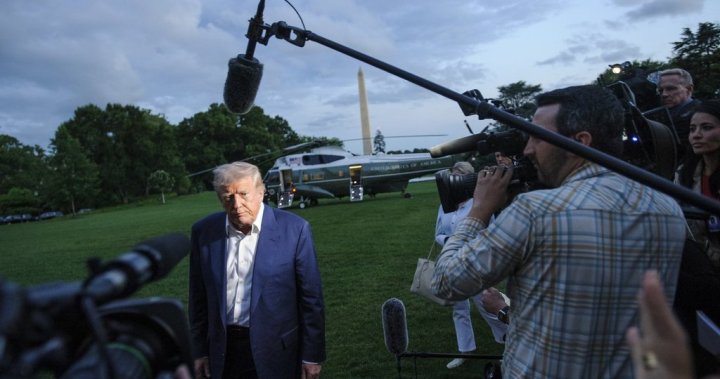President Donald Trump has opened a new salvo in his tariff war and is targeting films made outside the US
In a Sunday night post on his Truth Social Platform, Trump said he has granted approval to the US Department of Commerce and the US Trade Representative to slap 100% tariffs on “all films that come to our country that are produced abroad.”
“The American film industry is dying very fast deaths,” he wrote, complaining that other countries “providing all sorts of incentives to portray.”
It was not immediately clear how such tariffs on international production would be implemented. It is common for both large and small films to include production in the US and other countries. For example, big-budget films such as the upcoming Mission: Impossion – The Final Reckoning have been filmed all over the world.
The long-standing incentive program has influenced where the film is being filmed, and is increasingly promoting the production of films from other states and countries with favorable tax incentives, such as California, Canada and the UK.
But Trump's tariffs are designed to lead consumers to American products. And in cinemas, American-produced films are dominating the domestic market.
China has stepped up domestic film production and peaked with the animation blockbuster Ne Zha 2, earning over $2 billion this year. But even so, its sales came almost entirely from mainland China. In North America, it won just $20 million.

In New Zealand, where successive governments in recent years have provided rebates and incentives to bring Hollywood films out into the country, the film industry has generated billions of dollars in tourism revenue driven by the Lord of the Rings and the Hobbit movies. Recently, the blockbuster Minecraft film was shot entirely in New Zealand, and in 2023, US productions delivered $1.3 billion in New Zealand dollars (US$777 million) to the country in exchange for a $200 million subsidy.
New Zealand Prime Minister Christopher Luxon said he is waiting for details of Trump's action before commenting on them, but will continue to pitch to filmmakers overseas, including India's Bollywood. “We have an absolute world-class industry,” he said. “This is the perfect place to make a film in the world.”

Get daily national news
Get the top news, political, economic, and current events headlines of the day, delivered once a day to your inbox.
The Motion Picture Association, representing leading US film studios and streaming services, did not immediately respond to messages on Sunday evening.
MPA data shows that Hollywood's exports dominate cinemas. According to the MPA, American films produced US$22.6 billion exports and a trade surplus of US$15.3 billion in 2023.
More lifestyle details
Republican Trump did good things with the “customer man” label he gave himself years ago, slamming new taxes on goods made in countries around the world. This includes a 145% tariff on Chinese products and a 10% baseline tariff on goods from other countries, threatening an even higher tax.
Trend now

Calgary man fatally stabbing fitness instructor found guilty

Canadian Election: Ontario Riding Flip after the verification process
By imposing tariffs on unilaterally, Trump has had an extraordinary impact on commercial flows, creating political risks, and drawing markets in many directions. There are tariffs on automobiles, steel and aluminum, increasing imports, including pharmaceutical drugs, and will be subject to new tariffs in the coming weeks.
Trump has long voiced concerns about filmmaking moving abroad.
Shortly before he took office, he tapped actors Mel Gibson, John Voight and Sylvester Stallone to announce that he would work as a “special ambassador” for Hollywood, bringing “big, better, stronger than ever.”
The production of US film and television has been hampered in recent years, with set-offs from the Covid-19 pandemic, the 2023 Hollywood Guild strike and recent wildfires in the Los Angeles area. Overall US production fell 26% last year, according to ProdPro data tracking production.
According to the Hollywood Reporter, an annual survey of executives from the group asking about priority locations found that US locations were in the top five. Toronto, the UK, Vancouver, Central Europe and Australia took the lead, with California in sixth place, Georgia in seventh place, New Jersey in eighth place and New York in nineth place.
The problem is particularly serious in California. In the Greater Los Angeles region, production last year fell 5.6% from 2023 to 2023, according to Filmla, the second to 2020, at the peak of the coronavirus pandemic. Last October, Democrat Gov. Gavin Newsom proposed expanding California's Film & Television Tax Credit program to US$750 million per year. This is up from USD 330 million.
Other US cities, such as Atlanta, New York, Chicago and San Francisco, also use aggressive tax incentives to seduce film and television productions. These programs can take the form of cash grants and tax credits, like Texas, provided by Georgia and New Mexico.
“Other countries are stealing filmmaking capabilities from the United States,” Trump told White House reporters Sunday night after returning from the weekend in Florida. “If they're not willing to make a movie in the US, we should have tariffs on the movies that come in.”
– Contributed to this report from Washington in connection with the association between Gary Field, Washington, Wellington, New Zealand, and Charlotte Graham McCray of Washington.
Curator Recommendations

Celebrate Mother's Day with these gorgeous discoveries from Umbra

Six gardening tools to keep your outdoor space weed free

